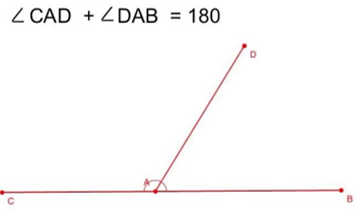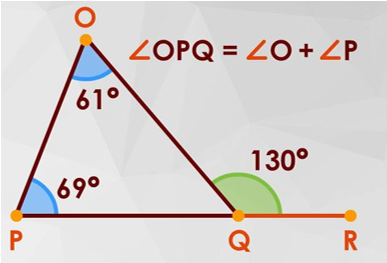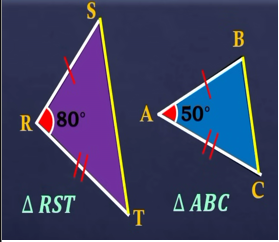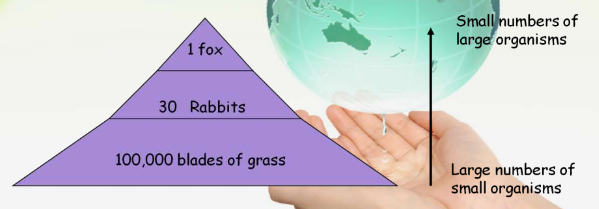Triangle Sum Theorem - The sum of three interior angles is always equal to 180°.
Linear Pair Postulate - If two angles form a linear pair, then they are supplementary angles.

Exterior Angles Theorem - For any triangles, the measure of an exterior angle is equal to the sum of its remote interior angles.

•Interior=Inside
•Exterior= Outside
•Adjacent= Near/Beside
•Remote=far/opposite
LESSON 2: Triangle Inequalities
Triangle Inequality Theorem - The sum of the lengths any two sides of triangle is greater than its third side.
Side-Angle Theorem- if one angle is larger than the other, then the side opposite the larger angle is the largest side.
Angle-Side Theorem-if one side is larger than the other, then the angle opposite the larger side is the largest angle.
LESSON 3: HINGE THEOREM
Hinge- a movable joint or mechanism on which a door, gate, or lid swings as it opens and closes or which connects linked objects.
Hinge theorem - It states that if two sides of a triangle is congruent to two sides of another triangle, and the included angle of the triangle is greater than the included angle of another, then the 3rd side of the 1st triangle is longer than the another.

CONVERSE OF HINGE THEOREM - It states that if two sides of a triangle is congruent to two sides of another triangle, and the 3rd side of the triangle is greater than the 3rd side of another, then the included angle of the 1st triangle is greater than the another.
LESSON 4: Probability
Probability - Is simply a numerical description of likely is something to happen.
Experiment - Is any activity that is performed wherein we arrive at desirable outcomes.
Sample Space - Is the set of all possible outcomes.
Event - Is a subset of a sample space.
Simple Event- it is an event that has a single outcome.

𝑺={𝑯,𝑻} (Coins) 𝑺={𝟏,𝟐,𝟑,…𝟔𝟎} (Draw) 𝑺={𝟏,𝟐,𝟑,𝟒,𝟓,𝟔} (Die)
A standard deck of playing cards contains 52 cards
Each suit (Hearts, Diamonds, Clubs, and Spades) has 13 cards: Ace, 2-10, Jack, Queen, and King. Some decks also include one or more jokers, which are not part of the 52 card standard deck
SCIENCE
Digestion - It is the process in which food is broken down into smaller molecules that the body can use to nourish the cells and to provide energy.
The five key processes of the digestive system are: ingestion, digestion (both mechanical and chemical), absorption, transport, and excretion
Mechanical Phase - Food is broken down into small pieces by the process of chewing or mastication. Food is also softened by the digestive juices such as saliva and gastric juice.
Mastication - chewing
Chemical Phase - Food is acted upon by chemical substances called enzymes that are secreted together with the digestive juices.
The tongue mixes the food with saliva and also helps in swallowing.
The salivary glands secrete saliva that lubricates food.
Swallowing pushes the food into the pharynx.
pharynx or throat - is located at the back of the mouth. It is the common passageway for digestion and respiration.
esophagus - is a muscular tube through which food passes from the pharynx to the stomach.
peristalsis - the process of transporting food through the esophagus
Stomach - is the expanded organ located between the esophagus and small intestine.
- Stores the swallowed food
- mixes food with the digestive juice it produce.
- conveys its content slowly into the small intestine.
Small intestine - is considered as the organ of complete digestion and absorption. It secretes enzymes that change food materials into their simplest form.
Large Intestine or Colon - is the next organ after the small intestine. It is divided into three parts: ascending colon, transverse colon, and descending colon.
- temporary stores fecal materials.
- absorbs vitamins produced by bacteria in the colon.
- reabsorbs water from undigested residue.
Rectum - is located at the end of the sigmoid colon and serves as a warehouse for feces.
anus - functions as the exit point of fecal materials.
salivary glands - secrete saliva, a chemical substance that is a combination of watery fluid and mucus.
- Parotid
- Sublingual
- submandibular
liver - is the largest organ in the body. It is located at the right side of the upper abdomen.
Bile - Is produced by the liver and it emulsifies fats and neutralizes the acidity of partly digested food that comes from the stomach.
Bile is temporarily stored and concentrated in the gallbladder.
pancreas - is a large, elongated gland located at the back of the stomach. It secretes digestive enzymes directly into the small intestine.
Gastroesophageal Reflux Disease (GERD) - A condition when the acid in the stomach goes to the esophagus.
Gallstones - Hard materials or deposits that are formed in the gallbladder.
Stomach Ulcer - This condition occurs when the thick layer of mucus that protects the stomach from the acid is reduced, affecting the tissues that line the stomach.
Irritable Bowel Syndrome (IBS) - This is a digestive problem that affects the colon or large intestine.
Appendicitis - An ailment that can cause pain in the lower right abdomen.
Indigestion - Also known as dyspepsia, a discomfort or pain experienced by a person in his or her upper abdomen.
Constipation - A digestive disorder wherein a person is having difficulty moving his or her bowel regularly.
Colorectal Cancer - A kind of cancer that starts in either the colon or the rectum.
LESSON 2
Why do Cells Divide? - For growth, repair, and reproduction
MITOSIS
• Organisms grow by the addition of cells
• In multicellular organism some of these cells perform functions different from other cells.(Cells have their own functions)
Differentiation - The process of a cell becoming different
• Under normal conditions once an animal cell becomes specialized it can no longer form an entire organism, however plant cells are totipotent and any cell can form an entire plant.
Most limiting factor in size is the size of the cell membrane.
• Cells must obtain nutrients
• as volume increases, cell surface area does not increase as greatly
• larger cells require a larger surface area for survival
Cytokinesis - The actual division of the cell into two new cells.
Mitosis - The division of the nucleus of the cell into two new nuclei.
Note: Sometimes cells go through mitosis without going through cytokinesis. Describe a cell that did this.
Chromatin - thin fibrous form of DNA and proteins
Sister chromatids - identical structures that result from chromosome replication, formed during S phase
Meiosis
A division of the nucleus that reduces chromosome number by half.
• Important in sexual reproduction
• Involves combining the genetic information of one parent with that of the the other parent to produce a genetically distinct individual
Diploid - two sets of chromosomes (2n), in humans 23 pairs or 46 total
Haploid - one set of chromosomes (n) - gametes or sex cells, in humans 23 chromosomes
Homologous pair
• each chromosome in pair are identical to the other ( carry genes for same trait)
• only one pair differs - sex chromosomes X or Y
SIMILARITIES
• Both are forms of nuclear division
• Both involve replication
• Both involve disappearance of the nucleus, and nucleolus, nuclear membrane
• Both involve formation of spindle fibers
DIFFERENCES
• Meiosis produces daughter cells that have 1/2 the number of chromosomes as the parent. Go from 2n to 1n.
• Daughter cells produced by meiosis are not genetically identical to one another.
• In meiosis cell division takes place twice but replication occurs only once.
Variation - differences between members of a population.
• Meiosis results in random separation of chromosomes in gametes.
• Causes diverse populations that over time can be stronger for survival.
LESSON 4: genetics: Mendel and Punnett Squares
Gregor Mendel
- Father of Modern Genetics
- Completed experiments on pea plants in his monastery’s garden
Studied seven independent traits in pea plants
- In the experiments he showed a basis for heredity and inheritance
- Mendel focused on Sexual reproduction, however that is not the only type of reproduction
Asexual reproduction - Asexual reproduction is when offspring are created from only one parent. Offspring are exact copies of that parent
Sexual Reproduction - Sexual Reproduction is combining the genetic information of two individuals to create a new individual
Alleles - Mendel found that each offspring gets half of its genetic makeup from each parent
- These halves are presented as individual Alleles Alleles can be named a, b, c, d and e
- Every individual has two Alleles for each trait
- With sexual reproduction each parent gives one Allele to the offspring
Alleles can be Dominant or Recessive, DOminant being capital and REcessive being small letters
Dominant alleles are shown and recessive is not.
Genotype determines Phenotype
- Genotype is the genetic makeup of an individual organism (Ee)
- Phenotype is a set of observable characteristics of an individual (Brown eyes)
Punnett Squares are used to determine the probability offspring will express a certain genotype. The Punnett Square takes the given genotype of the parents and shows the possible offspring genotype
Each set of alleles is designated as Homozygous Dominate (AA), Homozygous Recessive (aa), or Heterozygous (Aa)
LESSON 5
ecology - the meaning was given by German Biologist Haeckel in 1869.
Oikos or Logos - Greek word of “Ecology”
Oikos - habitat, house
Logos - to study
Eugenius Warming - The Danish Botanist, elaborated the idea of Ecology.
Ecology - is the study of interactions among organism or group of organisms with their environment. The environment consists of both biotic components (living organisms) and abiotic components (non – living organisms).
A.G. Tansley- The term Ecosystem was first proposed by them in 1935.
ecosystem - consists of the biological community that occurs in some locale, and the physical and chemical factors that make up its non-living environment
Ecosystem is the basic functional unit of Ecology.
A group of organisms interacting among themselves and with environment is known as ecosystem. Thus an ecosystem is a community of different species interacting with one another and with their non living environment exchanging energy and matter. Ecology is the study of ecosystems.
producers - autotrophs that make their own food thorugh Photosynthesis which turns sunlight into carbs
Consumers - Heterotrophs
Primary consumers - Herbivores
Secondary consumers - Primary Carnivores
Tertiary consumers - Secondary carnivores that feed on secondaries and depend on primary carnivores
omnivore - Organisms that feed both on plants and animals. Ex: Human, rat, birds.
detritivore - They feed on dead organisms, wastes of living beings and partially decomposed matter. Ex: Termites, earthworm, ants etc
Decomposers - attack the dead bodies of producers and consumers, and decompose them into simpler compounds
Natural ecosystem - These operate themselves under natural conditions. Based on habitat types, it can be further classified into three types
Terrestrial ecosystem - This ecosystem is related to land.
Aquatic ecosystem - This ecosystem is related to water. It is further sub classified into two types based on salt content
Fresh water:
Running water ecosystems. Ex: Rivers, Streams…
Standing water ecosystems Ex: Pond, lake…
Marine ecosystem. Ex: Seas and sea shores…
FUNCTION OF AN ECOSYSTEM
• Primary function: The primary function of all ecosystem is manufacture of starch (photosynthesis).
• Secondary function: The secondary function of all ecosystem is distribution energy in the form of food to all consumers.
• Tertiary Function: All living systems diet at a particular stage. These dead systems are decomposed to initiate third function of ecosystems namely “cycling”.
Energy - is the most essential requirement for all living organisms.
Solar Energy - the only source to our planet earth. It is transformed into chemical energy by plants
• Energy neither can be created nor destroyed, but it can be converted from one from to other
• Whenever energy is transformed, there is a loss of energy through the release of heat
FEEDING LEVELS
• The green plants or producers represent first tropic level T1
• The herbivores or primary consumers represent second tropic level T2.
• The carnivores or secondary consumers represent third tropic level T3.
• The tertiary consumers are fourth tropic level T4.
• Finally decomposers represent last tropic level T5.
MAIN TYPES OF FOOD CHAINS
• Grazing food chain: Found in Grassland ecosystems and pond ecosystems. Grazing food chain starts with green plants (primary producers) and goes to decomposer food chain or detritus food chain through herbivores and carnivores.
• Detritus food chain: Found in Grassland ecosystems and forest ecosystems. Detritus food chain starts with dead organic matter (plants and animals) and goes to decomposer food chain through herbivores and carnivores.
Bio-magnification - The non – biodegradable materials keep on passing from one tropic level to another. At each successive tropic level, the concentration keep on increasing.
ecological pyramid - Graphical representation of structure and function of tropic levels of an ecosystem, starting with producers at the bottom and successive tropic levels forming the apex
• Pyramid of numbers.
• Pyramid of energy.
• Pyramid of biomass.

FOREST ECOSYSTEM - an area with a high density of trees. A forest ecosystem is one in which tall trees grow that support many animals and birds. The forests are found in undisturbed areas receiving moderate to high rainfall. The forest occupies nearly 31% of the world’s land in India it is only 19% of total land area.
GRASSLAND ECOSYSTEM - occupies about 20% of earth’s surface. In addition to grass some trees and shrubs are/also present in grasslands. Limited grazing helps to improve the net primary production of the grasslands. But, overgrazing leads degradation of these grasslands resulting in desertification.
DESERT ECOSYSTEMS - occupies about 14% of our world’s land area. It is characterised by less than 25 cm rainfall. The atmosphere is dry and hence it is a poor insulator
AQUATIC ECOSYSTEMS - The aquatic ecosystem deals with water bodies. The major types of organisms found in aquatic environments are determined by the water’s salinity
FRESH WATER ECOSYSTEM POND ECOSYSTEMS - a fresh water aquatic ecosystems, where water is stagnant. It receives enough water during rainy season. It contains several types of algae, aquatic plants, insects, fishes and birds.
LAKE ECOSYSTEM - Lakes are large natural shallow water bodies. Lakes are used for various purposes. Lakes are supplied with water from rainfall, melting snow and streams.
SALT WATER ECOSYSTEMS. - Oceans cover more than two thirds of the earth’s surface. ocean environment is characterised by its high concentration of salts and minerals. It supplies huge variety of products and drugs. It also provides us iron, magnesium, iron, natural gas.
ESTUARINE ECOSYSTEM - An estuary is a partially enclosed coastal area at the’ mouth of a river, where sea water mixes with freshwater. It is strongly affected by tidal action. Estuaries are generally : abundant of nutrients. Estuaries are useful to human beings due to their high food potential. It is essential to protect the estuaries from pollution.